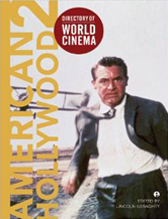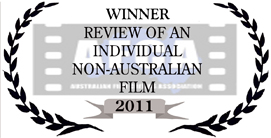
REVIEW: Uncle Boonmee Who Can Recall His Past Lives
Facing the jungles the hills and vales my past lives as an animal and other beings rise up
before me
Awarded the Palme d’Or at last year’s Cannes Film Festival, Uncle Boonmee Who Can Recall His Past Lives is as grand in themes as it is intimate in focus. Ruminating on death, the afterlife and reincarnation, Apichatpong Weerasethakul’s film centres around the final days of Boonmee (Thanapat Saisaymar), an ageing man suffering from kidney failure. Accompanied by his sister-in-law and nephew, Boonmee is unexpectedly revisited one night by his deceased wife and long lost son. Far from suggesting a dark, supernatural turn of events, the reappearance of the dead and missing in Uncle Boonmee merely prefigures the film’s exploration of mortality and personal memory.
 Indeed, the matter-of-fact manner in which Boonmee responds to his wife and child’s sudden re-emergence in that scene is in keeping with the still, almost meditative sensibility that underscores the film. Characterised by long single takes and static frames, the direction and cinematography of Uncle Boonmee repeatedly evokes the central character’s preoccupation with the past.
Indeed, the matter-of-fact manner in which Boonmee responds to his wife and child’s sudden re-emergence in that scene is in keeping with the still, almost meditative sensibility that underscores the film. Characterised by long single takes and static frames, the direction and cinematography of Uncle Boonmee repeatedly evokes the central character’s preoccupation with the past.
However, the sense of stillness that underlines Uncle Boonmee is also indicative of the film’s rural setting. Emphasising nature as an element within the cycle of life, death, and reincarnation, the film makes constant reference to the animals, insects and jungle terrain that surround Boonmee and constitute his existence. Unlike his sister-in-law Jen (on leave from her urban home) who complains about the ‘bugs’, migrant workers and living conditions, Boonmee’s spiritual identity is bound to the natural world. In that context, Uncle Boonmee certainly offers up comparisons with the films of Terrence Malick (The Thin Red Line) and his preoccupation with Heideggerian notions of nature and ‘being’. Like Malick’s protagonists, Weerasethakul depicts Boonmee’s communion with nature as a fundamental aspect of his acceptance of life/death.
 Beyond the film’s depiction of the natural world though, perhaps the most striking element of Uncle Boonme is its conception of time, images and memory. In this, Weerasethakul’s work shares more than a passing similarity to Chris Marker’s evocative masterpiece, Sans Soleil (1983). In a sequence consisting entirely of still photographs (a technique Marker also used within La Jetée) Boonmee narrates a dream about a future world in which time travellers are hunted down and erased when their image is projected upon a screen. Imagining death through a form of photographic projection, Uncle Boonmee Who Can Recall His Past Lives comments on the camera’s ability to capture a life (as a series of moments or memories) that is destined to disappear. It seems fitting then that by the end of the film both director and lead character have achieved a form of enlightenment. Weerasethakul has discovered in cinema the perfect metaphor for reincarnation: a form of representation in which – as Uncle Boonmee comes to realise – all things are at once both present and past.
Beyond the film’s depiction of the natural world though, perhaps the most striking element of Uncle Boonme is its conception of time, images and memory. In this, Weerasethakul’s work shares more than a passing similarity to Chris Marker’s evocative masterpiece, Sans Soleil (1983). In a sequence consisting entirely of still photographs (a technique Marker also used within La Jetée) Boonmee narrates a dream about a future world in which time travellers are hunted down and erased when their image is projected upon a screen. Imagining death through a form of photographic projection, Uncle Boonmee Who Can Recall His Past Lives comments on the camera’s ability to capture a life (as a series of moments or memories) that is destined to disappear. It seems fitting then that by the end of the film both director and lead character have achieved a form of enlightenment. Weerasethakul has discovered in cinema the perfect metaphor for reincarnation: a form of representation in which – as Uncle Boonmee comes to realise – all things are at once both present and past.





A beautiful review. Great call on the Malick connection.
I wondered how much meaning I lost by not being familiar with Thai spiritual/death rites, but I love your reading of the film with cinema as a metaphor for reincarnation.
Thanks Alice! I’m fairly certain there are moments of the film, perhaps the specific symbolism of the animals or the mythical references that were lost on me too but I couldn’t resist taking up the way Weerasethakul’s film was also commenting on cinema as a wonderfully apt medium for exploring reincarnation.
Not surprisingly, it’s a film I can’t seem to stop thinking about either.
I’m sorry, but I thought the film was awful. I believe in reincarnation and wanted to see how Uncle Boonmee’s past lives affected this life. However, the director was so self-indulgent, that he missed the point of story-telling altogether. Spending 2 minutes or more on one static dull scene does not depict meditation; instead, it depicts slowness. The movie was so slow, I thought I’d go to sleep. Nothing made any sense. Nothing connected to each other. What did the princess and the catfish have to do with Uncle Boonmee? I saw no correlation. If someone wants to make a meditative film, then do so with beautiful music and pictures. This was not one of those. It was slow, boring, and awkward. The title was very misleading. It should have been “Uncle Boonmee and a Bunch of Other Scenes.” I really thought it was horrible and I like most movies!
Donna,
Thanks for your comment. While I understand that people respond differently to works of art, I find the nature of your criticisms fairly spurious. Is it sufficient to accuse the director of self-indulgence merely because his approach to story-telling differs from the mainstream? Are you suggesting that there is but one ‘correct’ approach to story-telling (‘with beautiful music and pictures’)?
Also, did the film not make sense or is it a case of you not making sense of the film? I wonder if you have considered the source of Weerasethakul’s imagery/narrative or the cultural context of the symbolism. I’m not purporting to have ‘understood’ every aspect of ‘Uncle Boonme’ but to me that is not necessarily a fault of the film or filmmaker.
I’d be interested in your response to the various issues that I raised in the above review, in which I’ve attempted to articulate the links between the film’s pacing, structure, and symbolism to the themes of reincarnation, memory and nature.